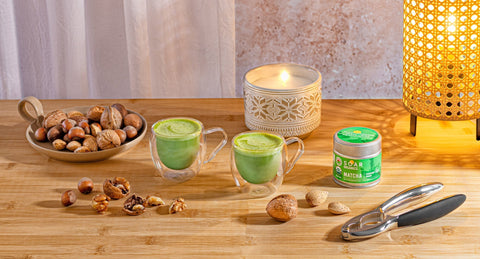Matcha, a finely ground green tea powder, has gained immense popularity not only for its health benefits but also for its unique flavor and vibrant color. One of the hallmarks of a well-prepared matcha is a smooth, frothy layer on top. However, achieving that perfect froth can be elusive. If your matcha isn't frothing as it should, we got you. Here are five common reasons why and how you can fix them.
1. Low-Quality Matcha
The Problem: Not all matcha is created equal. Culinary grade matcha, while suitable for cooking and baking, often lacks the quality needed for a smooth, frothy cup. The higher the quality, the finer the powder, which dissolves better and froths more easily.
The Solution: Consider a high quality ceremonial grade matcha for optimal froth. Even a versatile everyday grade matcha can often deliver the frothiness your heart desires. Look for vibrant green hue, as this indicates a higher chlorophyll content and freshness. Higher grades of matcha are specifically designed for drinking and tend to produce a better froth.
2. Improper Whisking Technique
The Problem: Whisking matcha requires a specific technique to achieve the desired froth. Simply stirring the powder with a spoon or using an incorrect whisking motion can result in a flat, lifeless cup.
The Solution: Use a traditional bamboo whisk (chasen) and whisk the matcha in a "W" or "M" motion rather than a circular motion. This helps incorporate air into the matcha, creating a creamy foam on top. Whisk briskly for about 20-30 seconds until you see a nice layer of froth. If you don't have a bamboo whisk, a handheld milk frother works great, too!
3. Incorrect Water Temperature
The Problem: Using water that is too hot can scald the matcha, resulting in a bitter taste and poor frothing. On the other hand, water that is too cold won't effectively dissolve the powder.
The Solution: The ideal water temperature for matcha is between 160°F and 175°F (70°C to 80°C). Boil the water and let it sit for a minute before pouring it over the matcha, or use a thermometer to ensure the temperature is just right. This will help preserve the delicate flavors and ensure better frothing.
4. Insufficient Sifting
The Problem: Matcha powder can clump together naturally, making it difficult to dissolve fully and froth properly. Skipping the sifting step can lead to a gritty texture and minimal foam.
The Solution: Always sift your matcha powder before adding water. Use a fine mesh strainer or a matcha sifter to break up any clumps. This ensures a smooth mixture and enhances the frothiness when whisked.
5. Improper Ratio of Matcha to Water
The Problem: Using too much or too little matcha powder in relation to the amount of water can affect the froth. Too much powder can make the mixture too thick to whisk properly, while too little powder can result in a weak froth.
The Solution: Follow the recommended ratio of about 1/2 to 1 teaspoon of matcha powder to 2-3 ounces (60-90 ml) of water. Adjust as needed based on your personal preference, but maintaining a proper balance is key to achieving a frothy matcha.
Bonus Tips for Perfect Matcha
- Use Fresh Matcha: Matcha loses its freshness quickly once opened. Store it in an airtight container in a cool, dark place, and use it within a few months for the best results.
- Whisk in a Bowl: A wide, shallow bowl (chawan) allows for better whisking motion and aeration compared to a narrow cup.
- Experiment with Milk: If you prefer a matcha latte, use a frother to whisk warm milk and add it to your matcha for a creamy, frothy treat.
By addressing these common issues, you can enhance your matcha preparation skills and enjoy a beautifully frothy, delicious cup every time. Happy whisking!



